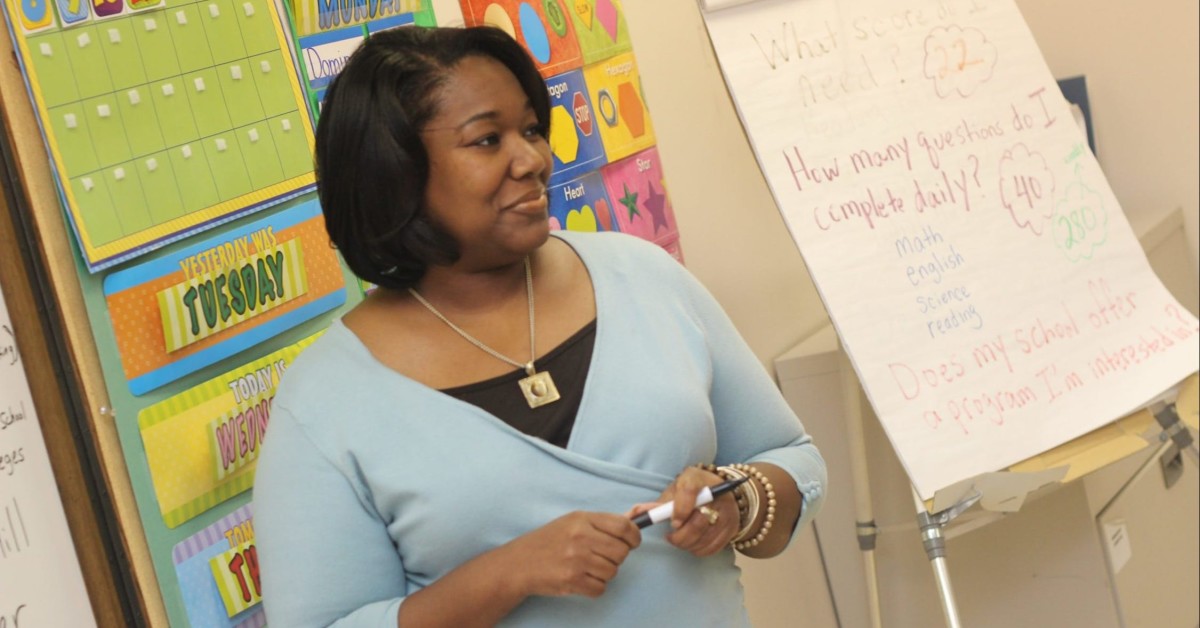
What Do Math Teachers Earn in 2020?
As a math teacher, you may qualify for higher pay [...]

Like many large cities, Washington, DC has struggled for years to recruit and retain teachers in their public and charter school system. One significant challenge has been retaining new teachers who are urgently needed to replenish the ranks of those retiring after years of service.
A recent Teach Plus poll found that at the outset of their careers, “77 percent of teachers felt that they were not fully prepared to be highly effective and meet the needs of many of their students.” Teachers outlined categories they felt would have strengthened their experience, noting that their programs “would have been stronger had they offered more instruction in classroom management (55%), differentiating instruction (53%) and teaching English language learners and special education students (47%), and longer clinical practice (39%) with more meaningful feedback (40%).”
In that same Teach Plus poll, one teacher offered, “Teacher preparation programs need to resemble…doctor’s residency programs. Great teachers take time, and we need to give time without the fear of repercussions given to fostering and building up those new to the teaching profession.” This observation captures the essence of the teacher residency program design, which is to allow new teachers to work applying theory and pedagogy learned in their education master’s program directly in the classroom, in real time, under the guidance of mentor teachers, just as newly-minted doctors do in medical residency programs.
Teacher residencies are offered through partnerships between universities or nonprofit educational organizations and schools/school districts. Instead of holding off teaching in-person toward the end of—or after—graduate school (as traditional teacher training programs do), student teachers spend a whole school year in the classroom, often logging around 1,000 hours of teaching, under the guidance of a mentor teacher. At the same time, these student teachers work to earn their master’s degree—typically a Master of Arts in Teaching (MAT)—or similar graduate education degree, as well as their teacher certification.
Typically, residencies consist of either a full or half-day teaching in the classroom—with coursework done at night and on weekends. Student teachers apply the lessons learned through their master’s degree coursework on a daily basis, while receiving feedback from their mentoring teachers throughout the academic year. In many cases, student teachers work in high-need public or charter schools, and commit to working full-time for a specific number of years after their residencies.
Residencies typically lead to teaching positions in schools in underserved communities. According to the National Center for Teacher Residencies (NCTR), Title I public schools (federally funding for schools serving low-income students) employ more than 90 percent of graduates from teacher residency programs (the NCTR notes that 94 percent of residents feel prepared for these high-needs environments after graduating). In these schools, oftentimes the teacher turnover rate is abysmal—50 percent higher than average according to the Learning Policy Institute. Teacher residency programs help address this attrition: 86 percent of graduates stayed in their residency schools for at least three years, according to the NCTR (which is the average number of years students teachers must commit to in order to keep their stipends).
| University and Program Name | Learn More |
|
New York University:
Master of Arts in Teaching
|
|
|
Merrimack College:
Master of Education in Teacher Education
|
Some applicants come directly from an undergraduate program, with a freshly-minted bachelor’s degree in teaching or a related area. Others are working professionals looking to change careers and enter the teaching field quickly and well-prepared. (Note: If you already hold a teaching certificate, you are ineligible for a teacher residency program.)
Traditionally, residency programs attract more students of color, helping to ensure that the diversity of the teaching staff reflects the diversity of the student body, particularly in urban areas. In its 2020 report, the National Center for Teacher Residencies (NCTR) found that more than 60% of teaching residents were people of color—40 percent higher than those entering from traditional programs. Additionally, the report found that over 20% of residents concentrate in STEM subjects, which also helps to address the dearth of these specialized teachers in schools across the country.
The Learning Policy Institute found that teacher experience corresponds with “student achievement gains”, especially in the early years of a teacher’s career. Residents also can also have a positive impact on their mentor teachers, who tend to increase their teacher effectiveness score (TES) in this role, according to a Glass Frog Solutions paper.
DC public schools coordinate initiatives with two main partner organizations: Relay Graduate School of Education and Urban Teachers.
As there are a number of programs available in the DC and Baltimore area, you’ll need to do your research to determine the one that might suit you best.
The application process will vary for each program, but many follow similar guidelines. While most will want a completed application, school transcripts, letters of recommendation, a bachelor’s degree and a minimum 3.0 GPA, they may also be looking for a well-written statement of purpose about why you want to go into teaching, particularly through a residency program, and how you see yourself as an effective teacher in the years ahead.
Working full-time under the guidance of a mentoring teacher will be its own challenge, but you’ll need to make time for your own studies as well. Curriculum will focus on real-world pedagogy, classroom management, diversity in learning, educational leadership and will work in concert with your classroom experience, and you’ll need to be able to work both ends of your education and professional development.
Your studies also may be different if you are pursuing a master’s degree or a teaching certification. Each program will present its own unique coursework.
Program participants might want to focus on special education, or work in an English as a second language (ESL) classroom, or work in STEM, secondary math, or secondary literacy. They may want to teach in early childhood, elementary education, at the middle or high school level, or in a public school or a public charter school. Examining your interests and career goals will help you find the right training program. You’ll also need to determine if you are pursuing a master’s degree or if you are hoping to gain a teaching credential during your year-long teacher training.
Teacher residency programs typically last a full year, with planning that begins in June and a completed program ending in August of the following year. Commitment to teaching post-graduation in the school system varies. Usually resident participants stay on to work as full-time teachers for anywhere from 2-5 years, depending on the program. While mentor teacher instruction is unique in the first year of training, guidance and support continues for the second year, and for the duration of the graduate’s employment.
There are unique opportunities in each residency, all designed to attract quality teaching candidates. Residency programs may offer stipends, tuition discounts or forgiveness, grants, salaries, or even health insurance to recent grads and professionals interested in enrollment.
The average salary for a Washington, DC public school teacher is about $66,474, with the range falling from a low of about $58,033 to a high of $76,741. High school teachers, on average, earn about $69,937. Teachers in the district who are in special education are paid about $64,293 on average.
You may make your way into the classroom, and never want to leave for the duration of your career.. But there are other paths that your teacher training can lead you to. Classroom management and leadership can prepare you for work as a career coach, curriculum developer, education policy analyst, museum educator or to administrative positions in a school or district. The call to teach may continue to be the rewarding career you imagined, but that unique skill set you gain in teacher training will prove valuable wherever you go.
(Last Updated on February 26, 2024)
Questions or feedback? Email editor@noodle.com

As a math teacher, you may qualify for higher pay [...]

If you're looking to quickly (and inexpensively) earn your MAT [...]

The beauty of online teacher residency programs is that after [...]

There are numerous teacher residency programs in urban areas across [...]

There are two distinct academic pathways aspiring OTs can take [...]
Categorized as: Elementary Education, Secondary Education, Education & Teaching